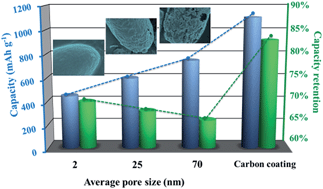Fabrication and structural optimization of porous single-crystal α-Fe2O3 microrices for high-performance lithium-ion battery anodes†
Abstract
Three-dimensional (3D) porous frameworks have shown great promise in the field of lithium-ion batteries (LIBs). However, the size effects of 3D porous frameworks on the structural and functional optimization are rarely reported. Herein, porous single-crystal α-Fe2O3 microrices synthesized through a facile one-pot hydrothermal method have been developed as a model system to investigate the correlations between the pore structure and LIB performance. A top-down chemical etching method was used to control the pore size and porosity of α-Fe2O3 microrices simultaneously over a wide range. α-Fe2O3 porous microrices were further coated with carbon to stabilize the structure. Electrochemical characterization shows that the increase of the pore size and total porosity leads to a higher specific capacity but poorer cycling performance. Carbon coating on the surface of α-Fe2O3 microrices significantly enhances the structural stability of particles and improves the cyclability of batteries. The obtained α-Fe2O3@C porous microrices exhibit a high capacity of ∼1107 mA h g−1 at a current density of 200 mA g−1, 83% capacity retention after 100 cycles and an excellent rate capability, which are among the best ones reported so far for α-Fe2O3 electrodes. Our results provide a general structural optimization strategy for porous oxides for high performance LIB anodes.



 Please wait while we load your content...
Please wait while we load your content...